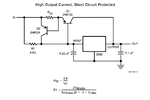dc443
Newbie level 3
Hi folks,
What I would like to do is quite simple. I want to take a 3-cell Lithium Polymer battery which has a nominal voltage of 11.1v (but when fully charged is well over 13v) and use it in an application requiring a 6- or 7-cell NiMH battery, that is, about 8V. This is simply because I want to reuse my R/C airplane batteries inside an R/C car. Why buy an expensive battery that weighs more, if I can build something cool that would be more weight efficient? Another reason is that I intend to mount some electronics on it which will be run off the lipo anyway.
Anyway, I'm having trouble figuring out what specific components I need to get this done. I know that I want a switching buck regulator of some sort. I would like it to be able to handle at least 20A. But I'm having some trouble parsing the datasheets. For example I'm looking at the LM27402 but I can't tell if I need to obtain some inductors and capacitors to connect to it as well.
edit: okay LM27402 is probably not something I can find anybody to sell to me easily.... probably isn't the right IC that I'm looking for either. What should I do then? Can I hook up a giant 4v diode to the battery? Do 4 volt diodes exist? I imagine it wouldn't be terribly efficient either, 4v at 20A is 80W.
What I would like to do is quite simple. I want to take a 3-cell Lithium Polymer battery which has a nominal voltage of 11.1v (but when fully charged is well over 13v) and use it in an application requiring a 6- or 7-cell NiMH battery, that is, about 8V. This is simply because I want to reuse my R/C airplane batteries inside an R/C car. Why buy an expensive battery that weighs more, if I can build something cool that would be more weight efficient? Another reason is that I intend to mount some electronics on it which will be run off the lipo anyway.
Anyway, I'm having trouble figuring out what specific components I need to get this done. I know that I want a switching buck regulator of some sort. I would like it to be able to handle at least 20A. But I'm having some trouble parsing the datasheets. For example I'm looking at the LM27402 but I can't tell if I need to obtain some inductors and capacitors to connect to it as well.
edit: okay LM27402 is probably not something I can find anybody to sell to me easily.... probably isn't the right IC that I'm looking for either. What should I do then? Can I hook up a giant 4v diode to the battery? Do 4 volt diodes exist? I imagine it wouldn't be terribly efficient either, 4v at 20A is 80W.
Last edited:
